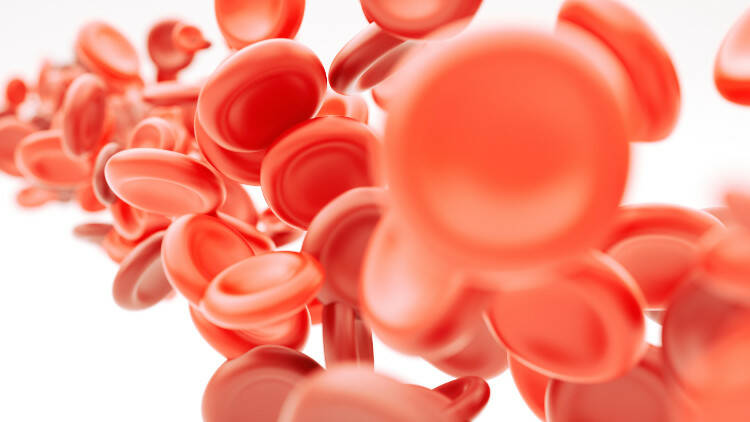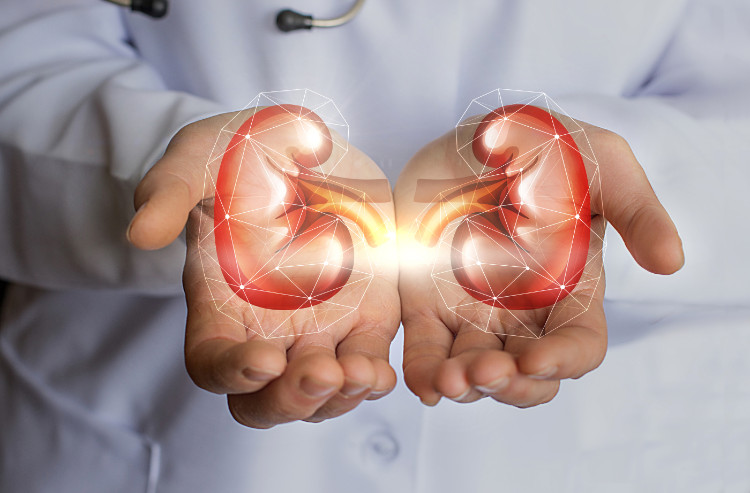Blood in the urine. You wouldn't expect it as a symptom of these diseases

The presence of blood in the urine (haematuria) is not a separate disease. It is a serious symptom of diseases of the kidneys, urinary tract. It occurs in a large number of other diseases or arises as a result of an accident. We can observe it when taking certain types of drugs or even when we are perfectly healthy. It occurs independently, but also as one of the symptoms. Sometimes it is visible to the naked eye, sometimes it is detected accidentally during microscopic examination of the urine. In some more serious diseases, the patient may even urinate blood coagules (clots). What all can cause it?
Article content
Blood in the urine often scares people a lot. The causes of its presence are various. It can be diseases, accidents, but also the use of certain drugs. When is it necessary to be afraid and when is the fear unfounded?
What is hematuria?
Hematuria is the presence of blood in the urine. It is a sign of a wide range of diseases. If you think that it occurs only in diseases of the urinary system, you are very mistaken. Even for nephrologists and general practitioners themselves, who come into contact with it first, it is often very difficult to differentiate its real cause. Quite often it happens that it remains unexplained.
Blood in the urine can be isolated or combined, where, along with red blood cells, we find the presence of, for example, erythrocyte cylinders, proteins, pus or bacteria in the urine sample.
Erythrocytes may be deformed in some diseases. All these facts, together with other examinations, help the doctor narrow down the range of possible causes by their presence or absence and help in differential diagnosis. Correct diagnosis is important for further treatment of the underlying causative disease.
Classification of haematuria according to the amount of blood in the urine
Blood in the urine can be visible to the naked eye, but also accidentally detected by examination of a urine sample.
You may not have known: Blood is present in the urine in a certain amount. It is not a pathological phenomenon. It becomes pathological if the amount exceeds the norm.
Macroscopic haematuria
Macroscopic hematuria is one that is visible to the naked eye. Urine changes its color from bright red through flesh color to brown. In some serious conditions, the patient may urinate up to coagula of blood (blood clots). Blood-colored urine means that the number of red blood cells in it is high. It can be observed if there is one or more milliliters of blood in a liter of urine.
Microscopic haematuria
Microscopic haematuria is also called erythrocyturia. As it is not visible, it is usually detected by a casual examination, for example, during a preventive check-up. It is detected by microscopic examination of the urinary sediment or by the paper indicator method. It is usually asymptomatic and may not cause any discomfort to the patient.
What diseases can hide behind the presence of blood in the urine?
It is not true that bloody urine occurs only in diseases of the urinary system. Of course, these may also manifest themselves in this way, but they are far from being the only ones. It is also encountered in other general diseases. Haematuria is divided into three basic categories, according to the part in which the true cause of its occurrence is located.
Prerenal haematuria
The name already implies that the pathological process is somewhere in the sites before the kidneys (pre-renal). We classify here diseases that are not related to disorders of the kidneys or the urinary system.
It includes general systemic diseases of which bloody urine is one of the many symptoms. Most of these diseases are very serious conditions associated with high mortality and blood in the urine is only one of their symptoms. Given their prognosis, it is a negligible symptom.
_1.jpg)
Blood cell diseases
- Haemophilia can be one of the causes. It is a genetic bleeding disorder. Specifically, the patient suffers from a deficiency of clotting factors VIII and IX, which are essential in the formation of blood clots. Because of this, the condition leads to excessive bleeding. Severe to life-threatening bleeding can be caused by a trivial trauma mechanism. However, the patient can bleed without an obvious cause.
- Autoimmune haemolytic anaemia is an autoimmune disease. Its cause is not yet understood. It is thought to be genetically determined and triggered by an unspecified infection. The basis of this disease is the excessive breakdown of red blood cells due to the influence of self antibodies that attack the cells themselves - erythrocytes.
- Insufficient formation of platelets or their too early death results in a condition called thrombocytopenia. The cause is also in this case the formation of autoantibodies and the trigger is various infections (upper respiratory tract infections, EBV virus, mumps or, less often, chickenpox). Acute occurrence is mainly in children, its chronic form is typical for adulthood. It is manifested by excessive bleeding into the subcutaneous tissue, organs, blood is also found in the urine.
Tumour diseases
- The most common cancer in developed countries is leukaemia. More specifically, it is a malignant disease of the blood. White blood cells proliferate and accumulate in the bone marrow. Mostly they are in their immature form. Their accumulation suppresses blood production. One of the typical manifestations of this disease is excessive bleeding.
- Hodgkin's lymphoma is a cancer of the lymph nodes, which is the primary cause of this malignant process. The exact cause is still unknown. It primarily affects the lymph nodes and can metastasize to other organs. About 10-15 % of patients have metastases in the bone marrow, where the tumour directly affects the haematopoietic system and manifests itself in a similar way to leukaemia.
Infectious diseases
- Measles is an infectious disease caused by the morbil virus. Due to its high infectiousness, it is subject to mandatory reporting and quarantine measures. It presents with typical exanthema on the skin and Koplik's spots on the palate. Its course may be without complications, but more severe symptoms such as mucosal bleeding may be encountered. Elevated erythrocyte counts are also found in the urine.
- diphtheria. Inflammation affects the tonsils, throat, sometimes nose, skin and conjunctivae. High mortality was observed in the period before the discovery of antibiotic treatment. However, complications are very common even now. Most often, it is paralysis of the soft palate, secondary infection of other organs and, last but not least, kidney damage accompanied by haematuria.
- Renal inflammation to renal failure with the presence of bloody urine tends to occur as a complication of scarlet fever. It occurs after the disease itself has subsided after about a week to a month. It is a particularly dangerous complication with the need for dialysis up to the inclusion of the patient for kidney transplantation, and can end in death if both sides are affected.
Other diseases and causes
- Hyperuricaemia is a disease characterised by increased uric acid production, decreased excretion or a combination of these factors. Its causes include poor diet, exposure to certain drugs, radiation, intoxication, as well as certain diseases such as diabetes, psoriasis, ARDS and others.
- Hypovitaminosis (C and K) - Vitamin deficiency is sporadic nowadays due to the abundance of dietary supplements. In the case of vitamin C deficiency, a disease called scurvy (common in the past in sailors, now almost non-existent) can occur. It is manifested by softening of the bones and teeth, bleeding of the gums and mucous membranes. Vitamin K plays an important role in coagulation. Its deficiency causes reduced clotting and bleeding conditions.
- Drugs help us in various diseases. Their effect is time-limited. They are excreted by the liver and kidneys. Traces of drugs are also found in the urine. Excessive use of drugs can cause kidney damage and subsequent haematuria. Drug-induced haematuria occurs mainly with antibiotic treatment, treatment with cytostatics or antiphlogistic drugs and other analgesics. Another group of drugs that directly affect the blood are anticoagulants. They are used to prevent thrombosis, pulmonary embolism and in acute myocardial infarction and after trauma.
Renal haematuria
This is the presence of blood in the urine due to some disease or pathological process directly affecting the kidney and its components. Damage to the kidney is caused by an inflammatory process, tumour growth or even obstruction and subsequent pressure on the renal parenchyma, for example by a concretion.

- Glomerulonephritis is an inflammatory disease of the glomeruli. Glomeruli are microscopic bodies inside the kidneys. They are shaped like a small club and are responsible for the filtration of blood. Urine is formed at these sites. In the case of inflammation, most often by streptococcal infection, blood passes into the newly formed urine. Glomerulonephritis can be acute or chronic and if left untreated is responsible for glomerular scarring and renal failure.
- Pyelonephritis occurs when the renal pelvis and kidney are inflamed. It is caused by bacteria that enter the kidney by the blood route from another site in the body. It can also spread to the kidney by the ascending route, for example from the bladder when it is inflamed. They usually affect one kidney unevenly, the disease can also be bilateral. The patient experiences pain when urinating, more often urination with a burning sensation, blood and bacteria are present in the urine.
- Obstructions of the uropoietic system can cause the urine produced to stagnate and build up pressure. The effect of the pressure expands the hollow system of the kidney. Such enlargement is called hydronephrosis. Hydronephrosis can also be congenital. A rare anomaly of the renal vessels is Fraleye's syndrome (named after its discoverer). These anomalies are the cause of nephralgia (kidney pain) and the presence of hematuria.
- The effect of nephrotoxic agents (antibiotics, chemotherapeutic agents, iodine contrast agents) or ischemia of the renal tubules results in renal necrosis. This is interstitial tubular damage with subsequent tubular necrosis.
- Polycystic kidney disease is the formation of multiple cystic formations in the kidney tissue. It is a relatively common genetic disease passed from parents to children. The recessive form is known to occur mainly in children. In this type, many small cysts form in the kidney, resulting in kidney failure. The other type is dominant polycystic disease. The cysts are fewer in number, larger and their pressure is responsible for the destruction of the kidney. It is not as progressive as the recessive form and the time before kidney failure is longer.
- Kidney tumours arise when cells in the kidneys start to multiply uncontrollably. The most common kidney tumour is adenocarcinoma. In children, the so-called Wilms tumour is less common. A kidney tumour grows and presses on healthy tissue. It can damage blood vessels, which then bleed. The blood leaks into the urine. The condition is usually associated with severe pain and other kidney complications. If diagnosed early, it can be treated. In later stages, kidney failure is a risk.
- Kidney injuries are a very common cause of bleeding into the kidney when the parenchyma of the kidney ruptures due to trauma. They occur in road accidents, falls from height, physical assaults and blows aimed at the retroperitoneum (lumbar part of the spine). Blood passes from the kidney into the urinary tract, bladder and exits with the urine through the urethra.
Postrenal haematuria
It accompanies diseases of the urinary system other than the kidneys. Diseases of the urinary tract and the bladder are included in this category. Most often these are various inflammations, as a result of which the patient urinates blood. Then there are concrements in the urinary tract, tumors and finally accidents.

- Cystitis is an inflammation of the bladder. It is very common, mainly in women. It is caused by bacterial infections. It manifests itself by frequent urination or an urge to urinate. When urinating, the patient feels a burning pain and urinates more often in smaller quantities. Macroscopic haematuria can be found in the urine. Pus and bacteria may also be present.
- Urolithiasis is actually the presence of calcium oxalate (a stem-forming substance) or a concrement in the urinary tract. The concrement (kidney stone) reaches different sizes. It can be stable in one place, but also mobile. Smaller stones can be urinated. Larger ones are removed surgically. There are several treatment options. The concrement causes pain mainly during movement, a problem with urination in the sense of not being able to urinate. In more severe cases, it causes complete urinary retention.
- Urinary tract obstruction is also caused by urinary tract tumours. The symptoms are similar to those of a kidney stone, except that the tumour cannot be urinated on. As the tumour grows, the obstruction and oppression of the surrounding tissue increases, resulting in twinges of pain, and, when the blood vessel is occluded, the presence of blood in the urine at a macroscopic level.
- Bladder tumours are one of the most common malignant diseases of the uropoietic system. They are the most common cause of macroscopic haematuria in general. They also present with lower abdominal pain, a feeling of bladder fullness, frequent urinary urgency in later stages and even the inability to urinate. Several types are known.
- Urinary tract and bladder injuries result in bleeding when one of the parts is damaged or ruptured. These are usually injuries with greater force.
- A healthy individual excretes approximately 130,000 red blood cells a day in the urine. With exertion, the excretion of red blood cells increases. This is called post-exertional haematuria. More common in athletes under heavy exertion. It disappears spontaneously after a period of rest. It is not considered pathological. The source of the haemorrhage is either the kidneys directly or the urinary tract.










